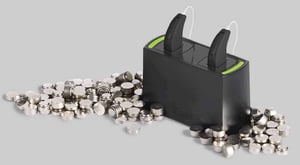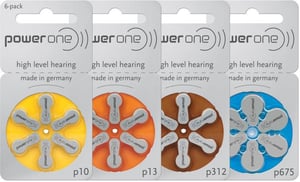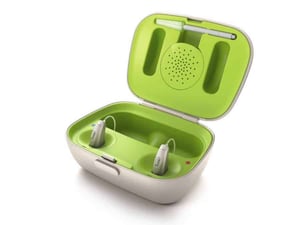Time To Read: 7 minutes
Battery technology has revolutionised hearing aids over the past thirty years.
From separate large battery packs to small button batteries and rechargeable models, hearing aids are more reliable than ever.
Rechargeables are the latest innovation on the market and have proved to be popular, but they may not necessarily be for everyone, so we’ll go through both so you can talk to your audiologist about which type is right for you and your lifestyle.
Batteries
 Hearing aid batteries are zinc-air models.
Hearing aid batteries are zinc-air models.
They generate electrical power from chemical reactions just like typical batteries, but cleverly, one of the reacting agents is oxygen. This means the batteries can be kept small which is ideal for hearing aids.
Activating the battery is as simple as removing the tab which covers the air holes. So only do this when you’re actually ready to use the battery.
Zinc-Air batteries are also non-toxic, with Mercury-free models favoured by manufacturers.
Their chief downside is the batteries may wear out faster in humid conditions. This is why we recommend opening the battery door of your hearing aids after you take them out for the night.
Hearing aid batteries come in four different sizes:
- Size 10 - 5.8 mm wide by 3.6 mm high
- Size 312 - 7.9 mm wide by 3.6 mm high
- Size 13 - 7.9 mm wide by 5.4 mm high
- Size 675 - 11.6 mm wide by 5.4 mm high
The reason for this is, generally speaking, is the larger the battery, the more power it has, which is important for hearing aids for those with severe and profound hearing loss.

To make it easy to find the right sized battery for your hearing aids, manufactures have colour-coded the packet:
- Size 10 batteries - yellow
- Size 312 batteries - brown
- Size 13 batteries - orange
- Size 675 batteries - blue
Depending on the power demands, batteries can last on average between three and twenty days:
- Size 10 - three to seven days
- Size 312 - three to 10 days
- Size 13 - six to 14 days
- Size 675 - nine to 20 days
Some hearing aid users who work in demanding and isolated occupations such as farming, mining and commercial fishing, often prefer batteries instead of rechargeable models to ensure their hearing aids don’t run out of power at inconvenient moments.
Find out more about rechargeable hearing aids and hearing aid batteries in this article.
Get extra life from your battery by following these tips.
Rechargeable batteries
 Many people enjoy the convenience of rechargeable hearing aids. In these, the batteries are built into the hearing aids, like your mobile phones.
Many people enjoy the convenience of rechargeable hearing aids. In these, the batteries are built into the hearing aids, like your mobile phones.
To recharge, the hearing aids are docked in a charging case and most people find it convenient to do that at the end of the day and let the hearing aids charge overnight.
Modern Lithium-Ion batteries (like the ones which power your mobile phone) will give you a full day’s use on a single charge. Some manufacturers like Oticon require as little as three hours charging to give you a full day’s use. Phonak boasts a full charge in two hours.
They are also ideal for those of us for whom dexterity is an issue. A number of clients have told us that they’re pleased not to have to worry about those fiddly battery doors any more.
Rechargeable hearing aids are excellent if you want to take advantage of some of the new Bluetooth and streaming facilities. These features are very convenient, but they are also power intensive.
Charging stations for these hearing aids have a USB cable which means you can recharge them in the car or plug them into portable power packs during camping or long international flights.
Other charging options
Fuel Cell
In early 2019, hearing aid manufacturer Widex showcased their hearing aid Evoke powered by the world's smallest commercially-available fuel cell. The Energy Cell technology allows users to recharge their hearing aids off the grid in just 20 seconds.
It was an interesting proof of concept which earned Widex the CES 2019 Best of Innovation Awards Honoree for the World’s First Battery-Free Hearing Aid.
To the best of our knowledge, there are no plans to roll out the technology with the latest reports from Widex promising a new Lithium-Ion (rechargeable) hearing aid model out during 2020.
Wireless charging
Inductive Wireless Charging
Inductive charging uses an electromagnetic field created by a magnetic coil to induce voltage in the receiver inside the device. This voltage is then used to charge the battery. This type of wireless charging is most commonly seen on charging pads, such as the one you may have for your phone.
RF Wireless Charging
Radio frequency wireless charging technology uses radio frequencies also transmitted through a wireless charger and picked up by a receiver within the device (not a coil) that is then converted into DC voltage.
It is a new technology with a lot of work to do before it is commercially ready.